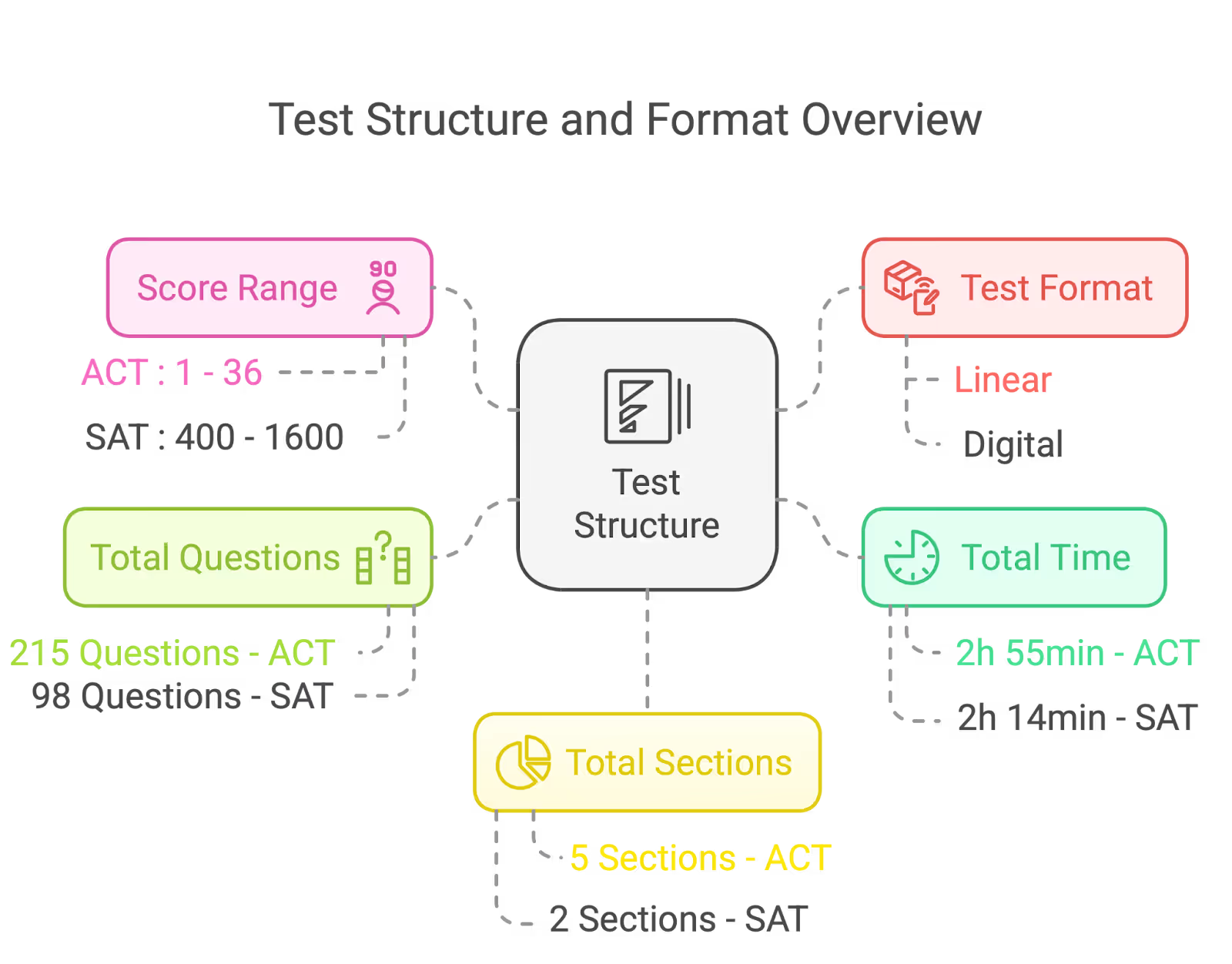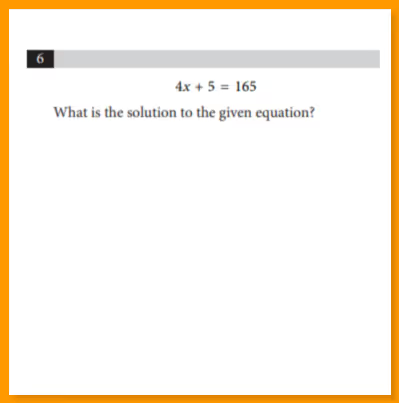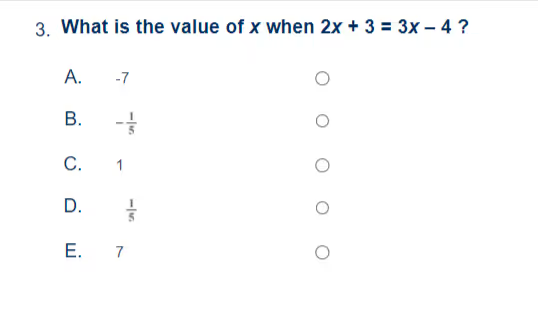


Key Takeaways
- The SAT is digital and adaptive, while the ACT remains linear, affecting question progression and timing per question.
- The SAT’s Math section makes up 50% of the score, benefiting math-strong students, whereas the ACT divides emphasis across sections.
- SAT passages are shorter and require deeper analysis, while ACT passages are longer with more direct questions, favoring faster readers.
One of the most common questions that high school juniors and seniors ask is ‘Should I take the SAT or ACT?’. In 2023, over 1.9 million took the SAT (SAT Annual Report) while nearly 1.4 million took the ACT (ACT Profile Report), so the confusion isn’t surprising.
Different states show different preferences over time. In popularity, the SAT has overtaken the ACT in states like Idaho and New Mexico. Against that, the ACT has more test-takers than the SAT in Nevada and Arizona (Source).
Before we compare the SAT and the ACT, it’s important to look at their similarities. Both are standardized tests evaluating college-readiness and both have math sections and reading passages. Also, neither of the tests penalizes students for wrong answers.
This article begins by studying the key differences between the SAT and the ACT. Next, we compare the sections of the SAT and ACT. We then examine how each test reports their standardized test scores. Finally, we conclude by helping you decide which of the two you should write.
But, first a quick overview of the facts, advantages, and disadvantages of the SAT and the ACT.
What is the SAT?
The SAT is a standardized test for college admissions. Anyone hoping for college admission in the USA may take the test, irrespective of where they are currently based.
The SAT is adaptive and now fully digital. It is conducted only on designated devices; the pencil-and-paper version was phased out in March 2022. Take a free practice digital SAT to see how it works.
It comprises two sections: the Reading and Writing section, and the Math section. Each section is divided into two sub-sections called modules. It is a multi-stage adaptive test, which means that the questions a student gets in the second module depend on their performance in the first module.
Although not mandatory, most colleges consider the SAT scores an important component of the admission process. It has been held since 1926, and a not-for-profit body called the College Board owns and conducts it.
Advantages of the SAT
Here are some of the advantages of the SAT:
- If you get a good score on the SAT, your chances for college admission improve considerably even if your bio-data isn't strong otherwise.
- There is clear evidence that preparing for the SAT improves SAT scores.
- It's a standardized test, so everyone competes on a level playing field.
Disadvantages of the SAT
Against the advantage mentioned above, there are some of the disadvantages of the SAT:
- It may not assess all your skills correctly.
- Using only the SAT scores to determine college-worthiness can be faulty.
What is the ACT?
Originally known by its full name American College Testing, the test is currently known only as the ACT. It is one of the two major tests whose scores are an important component for university admissions, including test-optional colleges.
Unlike its counterpart (the SAT), the ACT is linear and not adaptive. That means the questions on the test are fixed and do not vary based on your performance. In such tests, students sometimes feel less stressed because they don’t have to worry about the first module impacting their second module.
As of today, the ACT is conducted over computers only at international locations. Within the USA, test-takers can choose whether they'd like to go for the pencil-and-paper version or the digital version. It comprises four sections, each of which will be scored between 1 and 36.
Advantages of the ACT
Below are the advantages of taking the ACT:
- Till the ACT switches over to the digital model completely, students have the choice to decide between taking the pencil-and-paper version and the digital version.
- If your math skills are not particularly good, you might fare better with the ACT.
Disadvantages of the ACT
The ACT has its limitations too. Here are the two principal ones:
- Because it's not adaptive (not yet, at least), the ACT doesn't reflect the skill levels of all the test-takers with full accuracy.
- Fewer students take the ACT than take the SAT. Hence, you'll find fewer test-prep resources too.
SAT vs ACT: A quick overview
As two leading tests in the USA, the SAT and the ACT have quite a few differences. Some of them are quite significant, while others aren’t.

Here is a summary of how the two compare:
- The ACT is a little longer than the SAT. To be precise, the ACT will last 41 minutes more than the SAT.
- Both tests have a different fee waiver policy. Further details are available in the SAT fee waiver document and the ACT fee waiver program.
- In terms of number of questions, the ACT has over twice the number of questions as the SAT: 215 questions in the ACT versus 98 in the SAT. Of course, that alone doesn’t make the ACT more or less difficult than the SAT.
- The SAT has two sections, and both are divided into two subsections. Against this, the ACT has four sections.
- The SAT scores range from 400 to 1,600. The ACT composite scores range from 1 to 36. Again, this alone is not an indicator of the nature of these tests.
- The last major difference between the SAT and the ACT is important. The SAT is a digital, adaptive test. In contrast, the ACT is optionally digital in the USA, but it is linear in nature and not adaptive. This means that while the SAT will adapt its questions based on how the student has fared in the previous module, the ACT does no such adaptation. In other words, the ACT remains the same, no matter what your performance. Such tests that do not adapt to the student’s performance are called linear tests.
ACT vs SAT: Score Conversion
ACT vs SAT: What's the difference?
While the SAT and ACT are similar to some extent, they have vital differences. The time allotted per question, their scoring styles, the way they are administered, their preparation and test-taking strategies. There are many differences that matter to test-takers.
Let’s look at all the important differences between the SAT and the ACT.
Differences in the SAT and ACT Math sections
First, a simple fact: Some of the SAT questions are student-produced response questions, while the ACT has only multiple-choice questions.
Now let’s see how it impacts your test-taking strategy. Below are two screenshots; the first is a question from the ACT practice questions for math, while the second is from the SAT official practice test.


You’ll see that both questions test almost identical skills: solving an algebraic expression. But there’s a fundamental difference.
In the case of ACT, you have answer choices. So if you can’t think of anything else, you can simply plug the given value (in this case, the value of “x”). Whichever satisfies the expression is the correct answer.
With the SAT, there are no choices given. So the only way to get the correct answer is to solve the expression.
Of course, most SAT questions are multiple-choice questions, so this difference isn’t always a deciding factor. However, the absence of answer choices can turn an easy question into a moderately difficult question.
Besides this, there are other differences between the ACT math and SAT math sections. For instance, the ACT covers more syllabi, but the questions mostly test math concepts. The SAT, on the other hand, will involve more reading and thinking skills, so you’ll need to stop for a while and think through the question before you freeze your answer choice.
Reading and Writing Section: Key Differences between the ACT and the SAT
While both the SAT and the ACT assess the student’s linguistic skills, the nature and goals of their questions are slightly different. The ACT passages, for instance, are nearly five times as long as the SAT passages. That means students taking the ACT will have to develop the ability to read and understand longer passages.
Let us take up a few official ACT and SAT questions to see how the two are different.

(Source: Free official ACT practice test and ACT Official Practice Questions)
The screenshot above juxtaposes two different ACT reading questions. The one on your left requires you to not only take a broad view but also apply strong thinking skills. You need to understand the passage from a larger perspective and then extrapolate beyond what is directly stated. You’re unlikely to answer this question correctly without reading the entire passage.
Against that, the question on your right asks you about a particular detail (in this case, the McNaghten case). You can scan the passage quickly, spot the particular case, and answer the question. You don’t need to read the entire passage.
Now see the SAT question below

(Source: Collegeboard SAT practice test 1)
While the above SAT question also asks about the passage in general (“main purpose of the text”), there are only a few lines you need to read and understand. Because the text is short, you can read and re-read it till you’re sure you’ve found the answer.
The details are right there; no need to spend time looking for the right information. It’s just that you might need longer to think and eliminate the wrong choices.
So this is what it means. Because the ACT reading section has long passages, you’ll need to carry more information in your mind while you answer certain questions. In contrast, the SAT has shorter text to read but it can often be pithier.
In the strictest sense of the word, some students feel that the SAT Reading and Writing section should be called the Reading section in the SAT. That’s because the SAT optional essay section has been removed, so there’s no writing per se in the SAT. In contrast to that, the ACT has a writing section, albeit optional.
SAT vs ACT differences: What they mean to you
Okay, now you have enough information to compare the SAT and the ACT. But how do these ACT vs SAT differences impact your selection of tests and your test-taking strategies?
Let’s look at the five most important areas:
1. Time per question
Fact: The SAT gives you 2 hours 14 minutes for 98 questions: an average of 82 seconds per question. Against that, the ACT has 2 hours 55 minutes for 215 questions; an average of 48 seconds per question.
What it means for you: The SAT gives you almost double the time as the ACT. If you’re someone who needs more time to think, you’re probably better off with the SAT. On the other hand, if you’re better at quickly moving from one question to another, taking the ACT might be a good idea for you.
2. The Math section
Fact: On the SAT, the Math section contributes to 50% of your total SAT score. Against that, only 25% of the total ACT score comes from the Math section.
What it means for you: The message is clear: if Math isn’t your strong point, ACT is the test you want to write. On the other hand, if you are confident dealing with math questions, you’ll probably want to take the SAT.
3. Reading passages
Fact: The reading passages on the digital SAT are very short and each question corresponds to a different passage. Against that, the ACT passages are longer, and each passage is used for multiple questions.
What it means for you: While both tests evaluate your reading skills, they do it differently. Reading longer passages would require you to focus on the same passage for a much longer duration. The ACT has more questions - slightly easier too - but allows less time per question than the ACT. If that’s your strength, you’ll have an edge in the ACT.
Not a quick reader? You’ll be more comfortable with the SAT.
4. Science reasoning vs integrated analysis
Fact: The ACT includes a dedicated Science section focused on data interpretation, charts, and experiments. The SAT does not have a standalone Science section; science-based questions are integrated into Reading and Writing.
What it means for you: If you’re comfortable interpreting graphs, tables, and experimental data under time pressure, the ACT can play to your strengths. If you prefer science questions to be embedded within reading and writing tasks rather than isolated, the SAT may feel more natural.
5. Question style and reasoning depth
Fact: SAT questions often emphasize multi-step reasoning, evidence selection, and logical elimination. ACT questions are generally more direct but require faster execution.
What it means for you: If you like slowing down to analyze and reason through fewer questions, the SAT suits you better. If you prefer straightforward questions and can work quickly without overthinking, the ACT may be a better match.
6. Test adaptivity vs fixed difficulty
Fact: The Digital SAT uses a multistage adaptive format, where performance in the first module affects the difficulty of the second. The ACT follows a fixed-format structure with consistent difficulty throughout.
What it means for you: If you perform well early and like being rewarded for accuracy, the SAT’s adaptive format can work in your favor. If you prefer knowing exactly what to expect across the entire test, the ACT’s fixed structure may feel more predictable.
7. Calculator dependency
Fact: The Digital SAT allows calculator use throughout the Math section. The ACT allows calculators, but speed and mental math often matter more due to the pacing.
What it means for you: If you rely heavily on calculators and prefer structured problem-solving, the SAT may feel more comfortable. If you’re confident with faster calculations and mental math, the ACT can suit your style.
8. Retakes and score improvement strategy
Fact: Most colleges superscore both the SAT and ACT, but the SAT has fewer sections, while the ACT spreads scoring across more areas.
What it means for you: If you plan to retake the test to improve specific sections, the SAT may offer a clearer improvement path. The ACT can still be effective, but improvements may need to be more balanced across sections.
9. Perfect scores
Fact: The total SAT score is the simple total of your scores in both sections. Against that, your composite ACT score is the simple average of your scores across the four sections.
What it means for you: This might seem a bit paradoxical but it’s possible to achieve a perfect composite score of 36 on the ACT even if you didn’t get 36 on each section. That’s because the average will be rounded to the nearest whole number.
In the SAT, you can get a perfect 1,600 only if you score an 800 on both sections.
10. Other factors
Fact: As mentioned above, the ACT has more questions, but they are slightly easier. The SAT uses fewer questions but that raises the importance of individual questions.
What it means for you: The SAT math questions involve more thinking and reasoning when compared to the ACT. Those of you who would rather stick to the core concepts find ACT easier.
Further, because of a larger number of questions, you have a slightly larger margin for taking chances in the ACT. You can get up to six or seven questions wrong and yet achieve a perfect score. In the SAT, if you have more than three incorrect answers, it’s unlikely you can reach the perfect score.
ACT vs SAT - In Terms of Scoring
Although both the SAT and ACT are accepted equally by colleges, their scoring systems work very differently, which can influence how students perceive their performance and plan retakes.
The SAT is scored on a scale of 400 to 1600, combining two sections:
- Reading & Writing: 200–800
- Math: 200–800
Your total SAT score is the sum of these two section scores.
Each section score is calculated by converting raw scores (number of correct answers) into scaled scores using a standardized process.
Note: Because the Digital SAT is adaptive, question difficulty can influence the final score.
The ACT, on the other hand, uses a composite score system on a scale of 1 to 36. Each section, including English, Math, Reading, and Science, is scored individually from 1 to 36.
Your composite ACT score is the average of these four section scores, rounded to the nearest whole number. This means it’s possible to earn a high composite score even if one section score is slightly lower, as long as the overall average remains strong.
What This Means for You
The SAT places more weight on two core areas, making each section’s performance more critical. The ACT spreads scoring across four sections, which can offer more flexibility if one area is weaker.
While neither scoring system is “easier” or “harder,” the better choice depends on whether you prefer:
- A total score built from fewer sections (SAT), or
- A composite score averaged across multiple subjects (ACT)
Understanding how each test is scored can help you choose the exam that best aligns with your strengths and score-improvement strategy.
Do Colleges Prefer SAT or ACT?
Most colleges and universities do not prefer the SAT over the ACT, or vice versa. Admissions offices focus on how well a student performs relative to the test they choose. Both exams are treated equally in the admissions process, and schools use standardized test scores as one of many factors when reviewing applications.
Therefore, a strong SAT score and a strong ACT score carry the same weight, as long as they meet the institution’s expectations.
Many colleges are also test-optional, meaning students may choose whether or not to submit SAT or ACT scores. However, for students who do submit scores, colleges evaluate them using the same benchmarks and scholarship criteria regardless of the test.
ACT vs Digital SAT Score Concordance
ACT–SAT score concordance helps colleges and students compare scores from the ACT and the Digital SAT on a common scale. Because the two tests use different formats and scoring systems, concordance tables show which scores are considered equivalent in terms of college readiness.
For example, an ACT composite score of 30 is generally comparable to a Digital SAT score in the mid-1300s, while an ACT score of 24 roughly aligns with an SAT score in the 1100–1200 range.
These comparisons are based on large-scale data collected from students who have taken both exams.
Colleges rely on official concordance guidelines (published by testing organizations) to ensure fair evaluation and prevent students from being disadvantaged for choosing one test over another. This means admissions teams interpret ACT and SAT scores using equivalency, not raw numbers.
Which test should I write, the SAT or the ACT?
If you are a tutor, your students shouldn’t waste time trying to answer questions like ‘Is the SAT easier than the ACT?’ or ‘Do colleges prefer the ACT or the SAT?”. There’s no one-size-fits- all answer: what’s a great choice for Isabella may not be even half as good as her best friend Ron.
Answers to such questions are highly personalized, so it’s best to first speak to an admission expert. They will have all the tools and experience to guide students to make the right decision.
Alternatively, you can simply sign up and see for yourself how Edison can help your students and scale your own tutoring business. You have a 30-day trial, so that will give you more than enough time to explore and decide.
Whatever the case, the most important thing is to take action. Do it now!
How EdisonOS Helps Tutors Prepare Students for Digital SAT and ACT
EdisonOS is the comprehensive test prep platform for the Digital SAT and ACT. Stop having tutors manually build every practice test. EdisonOS provides Build Your Own Tests (BYOT) that takes 15 minutes instead of hours, bulk upload for instant question library creation, question analytics showing peer performance and difficulty percentages, and automated parental reporting that keeps families informed without admin work.
Enterprise firms choose EdisonOS because it saves 20-30 tutor hours per week on grading.
EdisonOS helps large test prep companies compete with free alternatives like Khan Academy. It provides accurate score predictions, question-level analytics with timing and peer data, week-over-week progress tracking, and authentic College Board digital interfaces.
One of the most significant aspects of EdisonOS is its attention to detail. They studied the Bluebook questions carefully to understand how the College Board arranges questions by difficulty level.
Using that as an absolute reference, EdisonOS next sourced questions that would be accurate replicas of real SAT questions. After that, they put together the practice test - a test which matches the actual SAT at every stage, in every question. Now, students can stop worrying about whether their preparations are going in the right direction and focus on areas they need to improve.
Frequently asked questions
The popularity of these exams varies by region and student preference. Historically, the SAT has been more prevalent on the East and West Coasts of the U.S., while the ACT dominates the Midwest and Southern states. However, in recent years, both exams have become widely accepted across the country and internationally. Many students choose based on the structure and content they feel more comfortable with, rather than regional preferences.
This depends on individual strengths: ACT: Faster-paced with more questions in a shorter amount of time. Includes a science section that tests data interpretation and analysis skills, not scientific knowledge. Allows calculator use throughout the math section. SAT: Offers slightly more time per question, making it less rushed. Focuses heavily on reading comprehension and problem-solving. Has a math section that prohibits calculator use for part of the exam. Students who prefer straightforward questions with tighter time constraints may favor the ACT, while those who excel at critical thinking and solving complex problems might perform better on the SAT.
While both exams test math concepts typically covered in high school, there are key differences: ACT Math: Covers algebra, geometry, trigonometry, and basic statistics. Includes 60 questions in 60 minutes. A calculator is allowed throughout the entire section. SAT Math: Emphasizes algebra, problem-solving, and data analysis. Includes a "no-calculator" section (20 questions) and a "calculator" section (38 questions). Provides 80 minutes for a total of 58 questions. Students comfortable with mental calculations and problem-solving without a calculator may prefer the SAT, while those who rely on calculator use might find the ACT easier.
To make an informed decision: Take full-length practice tests for both exams. Compare your scores and experience with each. Assess timing: If you struggle to finish questions on time, the ACT may feel more stressful. Evaluate subject strengths: If you're confident in science reasoning and quick problem-solving, the ACT might be a better fit. Conversely, if you have strong reading comprehension and algebra skills, the SAT may suit you better. Check college requirements: Most colleges accept both scores, so focus on maximizing your performance.
Many Indian students excel in the quantitative sections of the SAT due to their strong background in mathematics. However, the reading and writing sections may pose a challenge, as they require proficiency in analyzing dense, context-heavy passages. Exposure to Western literature, complex vocabulary, and logical reasoning can help Indian students perform better. Regular practice and mock tests are essential for success.

Tutors Edge by EdisonOS
in our newsletter, curated to help tutors stay ahead!
Tutors Edge by EdisonOS
Get Exclusive test insights and updates in our newsletter, curated to help tutors stay ahead!
Recommended Reads
Recommended Podcasts












.png)
.webp)
